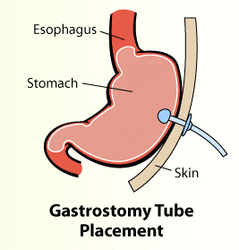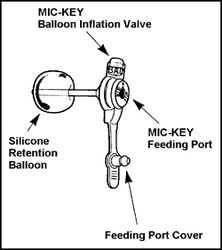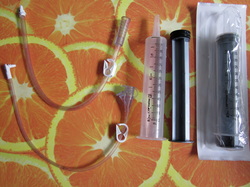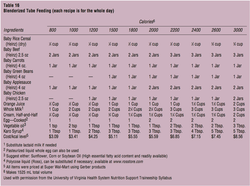ENTERAL FEEDING
Video with animation demonstrating PEG (g-tube) placement procedure
Video demonstrating how to feed through a g-tube (shows a Mic-Key button specifically)
Basic info & links
From University of South California:
Enteral feeding, or tube feeding, (as opposed to parenteral which is directly into the bloodstream via TPN, etc) is a way to deliver nutrients through a tube if you cannot take food or drink through your mouth. In some cases, you may only need tube feeding for a short period of time during your hospital stay. In other cases, you may need to go home with the tube in place and continue to receive nutrition this way. It may be temporary or permanent.
Depending on your condition, you may have a tube that leads from the:
Tube feeding provides you with proper nutrition when a condition makes it difficult, unsafe, or impossible to take food in through your mouth. Fluids and medicines can also be given through the tube.
Syringe Method
The feeding tube will be clamped or kinked. A large syringe will be attached to it. The formula will be poured slowly into the syringe. The tube will then be unclamped, and the syringe will be held high. This allows gravity to move the formula through the tube. When the feeding is done, the tube will be flushed with water to prevent clogging. The tube will then be clamped again, and the syringe will be removed. The tube will be re-capped and taped to the body. If the syringe method is used, you will need several feedings throughout the day. These are called bolus feedings.
Gravity-Drip Method
First, the formula will be poured into the feeding bag. The bag will be hung on a pole. The tube from the bag will be connected to the clamped feeding tube. Once the two tubes are connected, the feeding tube will be unclamped, allowing the formula to flow. As with the syringe method, gravity will move the formula through the tube. The flow can also be adjusted using a regulator clamp. When the feeding is done, a syringe filled with water will be used to flush the tube. Lastly, the tube will be capped and taped to your body. You will have several feedings during the day.
Pump Method
These steps are similar to the gravity-drip method. The difference is that the tubes are connected to an electronic pump. The pump will be programmed to deliver the formula at a set rate per hour. For example, with continuous feeding, you will slowly be fed throughout the day. If you need this approach, the feeding will be stopped every four hours. The tube will be flushed with water so that it does not get clogged. The pump method can also be used for bolus feedings.
How Long Will It Take?
More links:
The Oley Foundation (fantastic resources, newsletter, meetups, supply exchange, and forum)
Mic-Key Tube Youtube channel (Mic-Key is the type of g-tube I have)
PDF Document on all commercial enteral formulas, including those for people with allergies or other needs, as well as guidelines for homeblended
Enteral feeding, or tube feeding, (as opposed to parenteral which is directly into the bloodstream via TPN, etc) is a way to deliver nutrients through a tube if you cannot take food or drink through your mouth. In some cases, you may only need tube feeding for a short period of time during your hospital stay. In other cases, you may need to go home with the tube in place and continue to receive nutrition this way. It may be temporary or permanent.
Depending on your condition, you may have a tube that leads from the:
- Nose to the stomach (nasogastric)
- Abdominal wall to the stomach ( gastrostomy)
- Abdominal wall to the intestines ( enterostomy/jejunostomy)
Tube feeding provides you with proper nutrition when a condition makes it difficult, unsafe, or impossible to take food in through your mouth. Fluids and medicines can also be given through the tube.
Syringe Method
The feeding tube will be clamped or kinked. A large syringe will be attached to it. The formula will be poured slowly into the syringe. The tube will then be unclamped, and the syringe will be held high. This allows gravity to move the formula through the tube. When the feeding is done, the tube will be flushed with water to prevent clogging. The tube will then be clamped again, and the syringe will be removed. The tube will be re-capped and taped to the body. If the syringe method is used, you will need several feedings throughout the day. These are called bolus feedings.
Gravity-Drip Method
First, the formula will be poured into the feeding bag. The bag will be hung on a pole. The tube from the bag will be connected to the clamped feeding tube. Once the two tubes are connected, the feeding tube will be unclamped, allowing the formula to flow. As with the syringe method, gravity will move the formula through the tube. The flow can also be adjusted using a regulator clamp. When the feeding is done, a syringe filled with water will be used to flush the tube. Lastly, the tube will be capped and taped to your body. You will have several feedings during the day.
Pump Method
These steps are similar to the gravity-drip method. The difference is that the tubes are connected to an electronic pump. The pump will be programmed to deliver the formula at a set rate per hour. For example, with continuous feeding, you will slowly be fed throughout the day. If you need this approach, the feeding will be stopped every four hours. The tube will be flushed with water so that it does not get clogged. The pump method can also be used for bolus feedings.
How Long Will It Take?
- Syringe method: 15-20 minutes
- Gravity-drip method: 1-2 hours
- Pump method: varies depending on whether it is continuous feeding (eg, 8-12 hours) or bolus feeding
More links:
The Oley Foundation (fantastic resources, newsletter, meetups, supply exchange, and forum)
Mic-Key Tube Youtube channel (Mic-Key is the type of g-tube I have)
PDF Document on all commercial enteral formulas, including those for people with allergies or other needs, as well as guidelines for homeblended
MY FORMULAS
I was on Isosource HN with Fibre for the first few months after the tube placement but personally did horrible on it, which may be related to my gastroparesis. It made me incredibly nauseated and I had no energy while on it. Its ingredients basically consist of corn syrup, milk, soy protein, and canola and coconut oil. Its 300 cals/cup.
I was then switched to Compleat, a whole foods formula, made mostly from chicken, cranberries, milk, peas, carrots, and tomato, which I've done much better on; but as my calorie needs increased and I began to need more and more formula I began vomiting it up because the total amount of fat was too much for my stomach to digest properly; and my blood sugar was uncontrollably erratic. I now usually don't take in more than 2 cans of Compleat per day, and get the rest of my calories from a homeblended diet. I follow the diet from the gastroenterology newsletter, with modifications so that it fits the Gaastroparesis Diet, which I'll outline below. Compleat is 265 cals/cup.
I spent awhile trying out various homeblended diets; everything from the Standard American Diet to vegan, raw vegan, 80/10/10, fruitarian, paleo, Mediterranean, and a babyfood version of the Gastroparesis Diet. Of all those I did the best on the latter, until my GP deteriorated to such a point I could not tolerate anything but clear liquids and 2.0 formula (see below).
After my gastroparesis worsened I switched to Nutren 1.5. It is supposed to be ideal for high energy requirements and volume sensitivities. Its ingredients are similar to Isosource. It's 375 cals/cup. I then upgraded to Nutren 2.0, which has 500 cals/cup.
I was then switched to Compleat, a whole foods formula, made mostly from chicken, cranberries, milk, peas, carrots, and tomato, which I've done much better on; but as my calorie needs increased and I began to need more and more formula I began vomiting it up because the total amount of fat was too much for my stomach to digest properly; and my blood sugar was uncontrollably erratic. I now usually don't take in more than 2 cans of Compleat per day, and get the rest of my calories from a homeblended diet. I follow the diet from the gastroenterology newsletter, with modifications so that it fits the Gaastroparesis Diet, which I'll outline below. Compleat is 265 cals/cup.
I spent awhile trying out various homeblended diets; everything from the Standard American Diet to vegan, raw vegan, 80/10/10, fruitarian, paleo, Mediterranean, and a babyfood version of the Gastroparesis Diet. Of all those I did the best on the latter, until my GP deteriorated to such a point I could not tolerate anything but clear liquids and 2.0 formula (see below).
After my gastroparesis worsened I switched to Nutren 1.5. It is supposed to be ideal for high energy requirements and volume sensitivities. Its ingredients are similar to Isosource. It's 375 cals/cup. I then upgraded to Nutren 2.0, which has 500 cals/cup.
Homeblended Formula
If you would like to download the fullsize chart which outlines the ingredients and measurements to use for a nutritionally balanced homeblended diet, just click on the pic below and the larger version will open up. The brands of babyfood I use are Heinz and Beechnut, and every few weeks I get my brother to buy every variety on the shelf, so that I have constant variation in the diet to maximize total nutrition. Beechnut tends to have more calories per jar and less added spices/flavorings. In general I tend to avoid spicier varieties like Spanish Chicken which have a lot of onion and garlic because they upset my stomach.
Here are the substitutions I make; some are to add variety to the diet and some are to allow for my gastroparesis by lowering fat content. Note that I make up the calories lost from substituting out the whole milk and half and half cream by using full cups/7.5 oz jars of baby beef, chicken, and fruit, instead of the half to quarter measures on the chart. Here are my current ingredient substitutions (all mentions of pureed/strained means it's from a babyfood jar):
Note that I am only on 800-900 calories of homeblended per day, with an additional 500 calories from 2 cans Compleat, and a few hundred more calories from my Gatorade, because with my gastroparesis this is currently all I can tolerate. I usually get in about 1750 calories per day, which is far less than the 2600 I need (when sedentary, more when active). I can't tolerate more than this, and at this level, with substituting out the whole milk/half and half, I'm able to maintain the total fat at 50 g or less and the total fiber at 15 g or less, as recommended by the Gastroparesis Diet. I wouldn't be able to increase the calorie level very well without also increasing the fat/fiber content above my tolerable level. It's not an ideal situation, but it's better than when I could only tolerate 500 calories a day.
UPDATE: I stopped being able to tolerate the homeblended.
- Rice cereal - I use any baby cereal at all, whether made from rice, muesli, wheat, oats, barley, soya, or mixed with fruit.
- Baby beef/chicken - I occasionally substitute a can of Campbell's beef, chicken, or mutton soup for one of the 7.5 oz jars of babyfood.
- Baby green beans/carrots - I use any strained vegetable, or any canned one which is soft and easily digestible (i.e. no fibrous things like canned asparagus, and I tend to avoid green/wax beans and corn. I use things that are soft, like sliced carrots, diced beets, etc). I will sometimes substitute strained squash - pumpkin, butternut, etc - for one of the vegetable portions.
- Baby applesauce - I use any pureed/strained fruit variety, including ones mixed with yogurt or oatmeal, or I use canned peaches/pears. I personally tend to not use straight regular applesauce a lot since its fiber content causes some issues occasionally, but when it's pureed I seem to tolerate it fine.
- Orange juice - I use any fruit juice or vegetable juice, although I stay away from grapefruit juice because it's too acidic for me. I also tend to add some prune juice/nectar (1/4 or more) on top of everything to help with constipation since I have to have lower fiber content than other people.
- Whole milk/half and half cream - I use skim, rice, or soy milk instead to lower fat content, and often use some beef or chicken broth as well.
- Karo syrup - I use unpasteurized creamed honey instead.
- I also add a multivitamin/multimineral. I currently use pill form, blended, although I'm sure liquid form would be superior.
Note that I am only on 800-900 calories of homeblended per day, with an additional 500 calories from 2 cans Compleat, and a few hundred more calories from my Gatorade, because with my gastroparesis this is currently all I can tolerate. I usually get in about 1750 calories per day, which is far less than the 2600 I need (when sedentary, more when active). I can't tolerate more than this, and at this level, with substituting out the whole milk/half and half, I'm able to maintain the total fat at 50 g or less and the total fiber at 15 g or less, as recommended by the Gastroparesis Diet. I wouldn't be able to increase the calorie level very well without also increasing the fat/fiber content above my tolerable level. It's not an ideal situation, but it's better than when I could only tolerate 500 calories a day.
UPDATE: I stopped being able to tolerate the homeblended.




